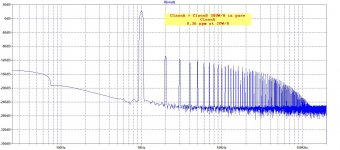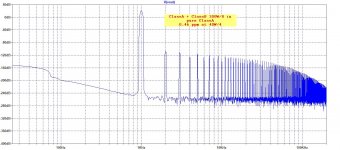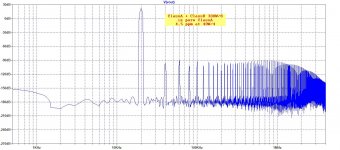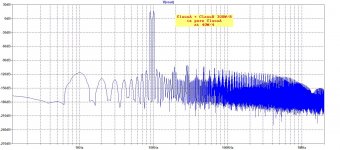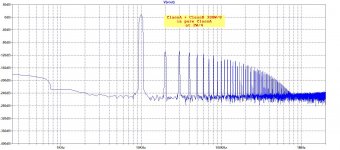No, it isn't necessarily that good to use these distortion canceling circuits. Charley Hansen tried them and said that while they lowered the measured distortion, they did NOT improve the sound quality.
My work with diamond buffers tends to disagree with your experiences John. They are in wide use because they are fast and use complimentary distortion to achieve their performance. Not unless you want to characterise them differently.
-Chris
-Chris
Do any of you recognize this? https://www.diyaudio.com/forums/solid-state/333197-mystery-amp-identification.html#post5679409
No, it isn't necessarily that good to use these distortion canceling circuits. Charley Hansen tried them and said that while they lowered the measured distortion, they did NOT improve the sound quality.
I dont believe that is universally true. Also, we have no idea what he tried. There is more than one ECF topology. But, if we are back to what some one "likes" then anyone's "like" or 'dislike' is fine.
Anyone here can read the book which shows before and after as well and try for themselves.
THx-RNMarsh
Last edited:
Do any of you recognize this? https://www.diyaudio.com/forums/solid-state/333197-mystery-amp-identification.html#post5679409
Wow, a blast from the past! I built a number of SWTP amps in the 1970s, including a pair of Tigersauruses!
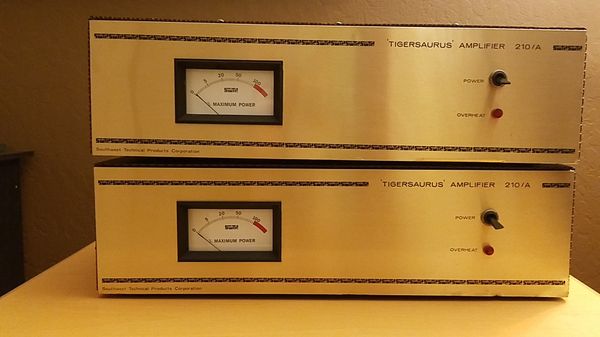
They were expensive to keep running, but looked pretty cool with big ol' meters... The regular Tiger was a good sounding stable design, however and a fantastic value at $1/watt:

I learned a lot about amp topology and repairing amps building SWTPC stuff...I also built their guitar amp head, digital instrument and other stuff, they were fun to build!
Howie
I haven't found info on the treble/bass/balance preamp board yet. The amp sounds really pleasurable but it does seem like it is probably flawed by some of the old capacitors and pots (instrument localization isn't great, but they sound real nice). This one is different because it has those lamps. The transistors being used are not the standard recommended onesl. I really wish I could just figure out how the hell to get under the amp boards to below... It's a serious puzzle box. You can't unbolt the transformer, and if you unbolt the metal holding the amps, it can't come out either... heh.
I wasn't even born when they came out.
The lamps do turn on during clipping it seems (only when amp is being pushed, the enclosure it came in that isn't anchored at all, wood, has little orange see through plastic things that go above the lamps). The input transistors are 6566, then there's a 6533 & 6530.
I wasn't even born when they came out.
The lamps do turn on during clipping it seems (only when amp is being pushed, the enclosure it came in that isn't anchored at all, wood, has little orange see through plastic things that go above the lamps). The input transistors are 6566, then there's a 6533 & 6530.
Last edited:
Hi Richard,
Now that`s a good idea. Scientifically responsible too.
-Chris
SOTA designs ---
View attachment OEC ECF.pdf
THx-RNMarsh
Last edited:
Kinda interesting. I'd want to see some current response info.
May or may not exist in the public domain. Someone might have be motivated enough to find out for themselves and then want to publish what they could perhaps otherwise use to make some money. What would you do?
This is my new ClassA 300W/4(ClassA + ClassB) just simulate but ready to be built. GNFB of course, I don't think that non GNF gives any advantage over it.
Attachments
Could you please show the result for 4ohm load at various amplitudes? 8ohm load is unrealistic, I do not know a usual speaker that would have impedance equal or above 8ohm in the whole frequency range. I know that 8ohm results are nicer, but for the real world, useless.
This is still being discussed, usually by those selling non GFB as somehow preserving phase purity, as far as I can gather, it can be heard but not measured, they say. Really? Can minute modulations that can't be measured affect sound stage in such an apparently dramatic way?GNFB of course, I don't think that non GNF gives any advantage over it.
People like low/no gnfb because it makes the music sound less like it was done in a studio. Although as discussed earlier sometimes due to the speaker driver the feedback isn't exactly doing any favors... and current drive could help some of the situations.
People like low/no gnfb because it makes the music sound less like it was done in a studio.
That's a good point. I have a theory that it causes correlated distortions that can be perceived as improving the 3D imagery, equally unprovable, probably.
That's a good point. I have a theory that it causes correlated distortions that can be perceived as improving the 3D imagery, equally unprovable, probably.

Problem is, others like amplifiers with huge amounts of GNFB. I'm really not sure how many people believe feedback is bad and are therefore disposed to low feedback designs, despite the evidence that 6-12dB of NFB is often far worse than none at all.
Could you please show the result for 4ohm load at various amplitudes? 8ohm load is unrealistic, I do not know a usual speaker that would have impedance equal or above 8ohm in the whole frequency range. I know that 8ohm results are nicer, but for the real world, useless.
I showed this FFT to compare with one Richard showed from Kulinummi Audio Power Amplifiers book.
Here are some more.
Attachments
The worst example of ‘feedback is bad’ I’ve seen is on the Audio Note website. All the usual feedback tropes are there - clearly Colloms acolytes.
Amplifier designers who eschew feedback would do well to remember nature abounds with it. Just take a look at the metabolic pathways in a living organism, or try to explain stellar nuclear fusion in a stable main sequence star like our sun without it. Good luck on that one . . .
Feedback: A Short History
Amplifier designers who eschew feedback would do well to remember nature abounds with it. Just take a look at the metabolic pathways in a living organism, or try to explain stellar nuclear fusion in a stable main sequence star like our sun without it. Good luck on that one . . .
Feedback: A Short History
- Status
- Not open for further replies.
- Home
- Member Areas
- The Lounge
- John Curl's Blowtorch preamplifier part III
